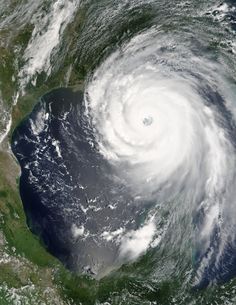Natural disaster
A natural disaster is the effect of a natural hazard (e.g., flood, tornado, hurricane, volcanic eruption, earthquake, or landslide) that affects the environment, and leads to financial, environmental and/or human losses. The resulting loss depends on the capacity of the population to support or resist the disaster, and their resilience.[1] This understanding is concentrated in the formulation: "disasters occur when hazards meet vulnerability."[2] A natural hazard will hence never result in a natural disaster in areas without vulnerability, e.g. strong earthquakes in uninhabited areas. The term natural has consequently been disputed because the events simply are not hazards or disasters without human involvement.[3]
Contents |
Natural disasters
Land movement disasters
Avalanches

Notable avalanches include:
- The 1910 Wellington avalanche
- The 1954 Blons avalanches
- The 1970 Ancash earthquake
- The 1999 Galtür Avalanche
- The 2002 Kolka-Karmadon rock ice slide
- The 2008 Wenchuan earthquake
- The 2010 Haiti earthquake
- The 2010 Chile earthquake
- The 2010 Yushu earthquake
- The 2010 Pacaya Volcano ash disaster
Earthquakes
An Earthquake is a sudden shake of the Earth's crust caused by the tectonic plates colliding.The vibrations may vary in magnitude. The underground point of origin of the earthquake is called the "focus". The point directly above the focus on the surface is called the"epicenter". Earthquakes by themselves rarely kill people or wildlife. It is usually the secondary events that they trigger, such as building collapse, fires, tsunamis (seismic sea waves) and volcanoes, that are actually the human disaster. Many of these could possibly be avoided by better construction, safety systems, early warning and evacuation planning.Earthquakes are caused by the discharge of accumulated along geologic fault.
Lahars
A lahar is a volcanic mudflow or landslide. The 1953 Tangiwai disaster was caused by a lahar, as was the 1985 Armero tragedy in which the town of Armero was buried and an estimated 23,000 people were killed.
Volcanic eruptions
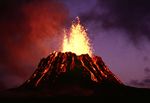
- An Eruption may in itself be a disaster due to the explosion of the volcano or the fall of rock but there are several effects that may happen after an eruption that are also hazardous to human life.
- Lava may be produced during the eruption of a volcano a material consisting of superheated rock. There are several different forms which may be either crumbly or gluey. Leaving the volcano this destroys any buildings and plants it encounters.
- Volcanic ash - generally meaning the cooled ash - may form a cloud, and settle thickly in nearby locations. When mixed with water this forms a concrete like material. In sufficient quantity ash may cause roofs to collapse under its weight but even small quantities will cause ill health if inhaled. Since the ash has the consistency of ground glass it causes abrasion damage to moving parts such as engines.
- Supervolcanoes : According to the Toba catastrophe theory 70 to 75 thousand years ago a super volcanic event at Lake Toba reduced the human population to 10,000 or even 1,000 breeding pairs creating a bottleneck in human evolution. It also killed three quarters of all plant life in the northern hemisphere. The main danger from a supervolcano is the immense cloud of ash which has a disastrous global effect on climate and temperature for many years.
- Pyroclastic flows consist of a cloud of hot volcanic ash which builds up in the air above under its own weight and streams very rapidly from the mountain burning anything in its path. It is believed that Pompeii] was destroyed by a pyroclastic flow.
Water disasters
Floods

Some of the most notable floods include:
- The Huang He (Yellow River) in China floods particularly often. The Great Flood of 1931 caused between 800,000 and 4,000,000 deaths.
- The Great Flood of 1993 was one of the most costly floods in United States history.
- The 1998 Yangtze River Floods, also in China, left 14 million people homeless.
- The 2000 Mozambique flood covered much of the country for three weeks, resulting in thousands of deaths, and leaving the country devastated for years afterward.
Tropical cyclones can result in extensive flooding and storm surge, as happened with:
- Bhola Cyclone, striking East Pakistan (now Bangladesh) in 1970,
- Typhoon Nina, striking China in 1975,
- Tropical Storm Allison, which struck Houston, Texas in 2001 and
- Hurricane Katrina, which left most of New Orleans under water in 2005. Much of the flooding was due to the failure of the city's levee system.
Limnic eruptions

A limnic eruption occurs when a gas, usually CO2 suddenly erupts from deep lake water, posing the threat of suffocating wildlife, livestock and humans. Such an eruption may also cause tsunamis in the lake as the rising gas displaces water. Scientists believe landslides, volcanic activity, or explosions can trigger such an eruption. To date, only two limnic eruptions have been observed and recorded:
- In 1984, in Cameroon, a limnic eruption in Lake Monoun caused the deaths of 37 nearby residents.
- At nearby Lake Nyos in 1986 a much larger eruption killed between 1,700 and 1,800 people by asphyxiation.
Tsunami
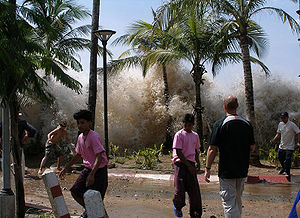
Tsunamis can be caused by undersea earthquakes as the one caused in Ao Nang, Thailand, by the 2004 Indian Ocean Earthquake, or by landslides such as the one which occurred at Lituya Bay, Alaska.
- Ao Nang, Thailand (2004). The 2004 Indian Ocean Earthquake created the Boxing Day Tsunami and disaster at this site.
- Lituya Bay, Alaska (1953). A mega-tsunami occurred here, the largest ever recorded.
(This also fits within the "Land movement disaster" category because it started with an earthquake.)
- See also 2010 Chile earthquake
Weather disasters
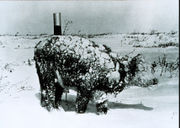
Blizzards
Significant blizzards in the United States include:
- The Great Blizzard of 1888
- The Schoolhouse Blizzard earlier the same year
- The Armistice Day Blizzard in 1940
- The Storm of the Century in 1993
Cyclonic storms
Cyclone, tropical cyclone, hurricane, and typhoon are different names for the same phenomenon a cyclonic storm system that forms over the oceans. The deadliest hurricane ever was the 1970 Bhola cyclone; the deadliest Atlantic hurricane was the Great Hurricane of 1780 which devastated Martinique, St. Eustatius and Barbados. Another notable hurricane is Hurricane Katrina which devastated the Gulf Coast of the United States in 2005.
Droughts
Well-known historical droughts include:
- 1900 India killing between 250,000 and 3.25 million.
- 1921-22 Soviet Union in which over 5 million perished from starvation due to drought
- 1928-30 northwest China resulting in over 3 million deaths by famine.
- 1936 and 1941 Sichuan Province China resulting in 5 million and 2.5 million deaths respectively.
- As of 2006, states of Australia including Western Australia, New South Wales, Victoria and Queensland had been under drought conditions for five to ten years. The drought is beginning to affect urban area populations for the first time.
- In 2006, Sichuan Province China experienced its worst drought in modern times with nearly 8 million people and over 7 million cattle facing water shortages.
Hailstorms
Hailstorms (AKA hailstones) are rain drops that have formed together into ice. A particularly damaging hailstorm hit Munich, Germany, on July 12, 1984, causing about 2 billion of dollars in insurance claims.
Heat waves
The worst heat wave in recent history was the European Heat Wave of 2003.
A summer heat wave in Victoria, Australia, caused the massive bushfires in 2009. Melbourne experienced three days in a row of temperatures exceeding 40°C. The bushfire, otherwise known as "Black Saturday" was also started intentionally.
Tornadoes
Different Types of Tornadoes:
Supercell Tornadoes
Some of the most violent tornadoes develop from supercell thunderstorms. A supercell thunderstorm is a long-lived thunderstorm possessing within its structure a continuously rotating updraft of air. These storms have the greatest tendency to produce tornadoes, some of the huge wedge shape. The supercell thunderstorm has a low-hanging, rotating layer of cloud known as a "wall cloud." It looks somewhat like a layer of a layer cake that hangs below the broader cloud base. One side of the wall cloud is often rain-free, while the other is neighbored by dense shafts of rain. The rotating updraft of the supercell is seen on radar as a "mesocyclone."
The tornadoes that accompany supercell thunderstorms are more likely to remain in contact with the ground for long periods of time—an hour or more—than other tornadoes, and are more likely to be violent, with winds exceeding-200 mph.
Landspout
Generally weaker than a supercell tornado, a landspout is not associated with a wall cloud or mesocyclone. It may be observed beneath cumulonimbus or towering cumulus clouds and is the land equivalent of a waterspout. It often forms along the leading edge of rain-cooled downdraft air emanating from a thunderstorm, known as a "gust front."
Gustnado
Weak and usually short-lived, a gustnado forms along the gust front of a thunderstorm, appearing as a temporary dust whirl or debris cloud. There may be no apparent connection to or circulation in the cloud aloft. These appear like dust devils.
Waterspout
A waterspout is a tornado over water. A few form from supercell thunderstorms, but many form from weak thunderstorms or rapidly growing cumulus clouds. Waterspouts are usually less intense and causes far less damage. Rarely more than fifty yards wide, it forms over warm tropical ocean waters, although its funnel is made of freshwater droplets condensed from water vapor from condensation - not saltwater from the ocean. Waterspouts usually dissipate upon reaching land.
The following are tornado-like circulations
Dust Devils
Dry, hot, clear days on the desert or over dry land can bring about dust devils. Generally forming in the hot sun during the late morning or early afternoon hours, these mostly harmless whirlwinds are triggered by light desert breezes that create a swirling plume of dust with speeds rarely over 70 mph. These differ from tornadoes in that they are not associated with a thunderstorm (or any cloud), and are usually weaker than the weakest tornado.
Typically, the life cycle of a dust devil is a few minutes or less, although they can last much longer. Although usually harmless, they have been known to cause minor damage. They can blow vehicles off the road and could damage your eyes by blowing dust into them.
Firewhirls
Sometimes the intense heat created by a major forest fire or volcanic eruption can create what is known as a firewhirl, a tornado-like rotating column of smoke and/or fire. This happens when the fire updraft concentrates some initial weak whirl or eddy in the wind. Winds associated with firewhirls have been estimated at over 100 mph. They are sometimes called fire tornadoes, fire devils, or even firenadoes.[4]
Fire
Wildfires are an uncontrolled fire burning in wildland areas. Common causes include lightning and drought but wildfires may also be started by human negligence or arson. They can be a threat to those in rural areas and also wildlife.
A notable case of wildfire was the 2009 Victorian bushfires in Australia.
Nine elderly Russians have died in a blaze at a nursing home that may have been started by a resident setting himself on fire.The fire at the facility in Tver, northeast of Moscow, injured two others and forced the evacuation of some 480 people early on Monday,and investigators found a canister of flammable liquid in the room where the fire started, leading to speculation the resident set himself ablaze.
Health and diseases
Epidemic
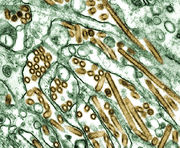
An epidemic is an outbreak of a contractible disease that spreads at a rapid rate through a human population. A pandemic is an epidemic whose spread is global. There have been many epidemics throughout history, such as Black Death. In the last hundred years, significant pandemics include:
- The 1918 Spanish flu pandemic, killing an estimated 50 million people worldwide
- The 1957-58 Asian flu pandemic, which killed an estimated 1 million people
- The 1968-69 Hong Kong flu pandemic
- The 2002-3 SARS pandemic
- The AIDS epidemic, beginning in 1959
- The H1N1 Influenza (Swine Flu) Pandemic 2009-2010
Other diseases that spread more slowly, but are still considered to be global health emergencies by the WHO include:
- XDR TB, a strain of tuberculosis that is extensively resistant to drug treatments
- Malaria, which kills an estimated 1.6 million people each year
- Ebola hemorrhagic fever, which has claimed hundreds of victims in Africa in several outbreaks
Famine
In modern times, famine has hit Sub-Saharan Africa
Space
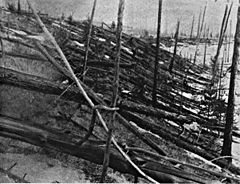
Gamma ray bursts
Impact events
One of the largest impact events in modern times was the Tunguska event in June 1908.
Solar flares
A solar flare is a phenomenon where the sun suddenly releases a great amount of solar radiation, much more than normal. Some known solar flares include:
- An X20 event on August 16, 1989
- A similar flare on April 2, 2001
- The most powerful flare ever recorded, on November 4, 2003, estimated at between X40 and X45
- The most powerful flare in the past 500 years is believed to have occurred in September 1859
Supernovae and hypernovae
Future of natural disasters
The United Kingdom based charity Oxfam publicly stated that the number of people hit by climate-related disasters is expected to rise by about 50%, to reach 375 million a year by 2015.[5]
Insurance
Natural disasters play a major role in the insurance industry, which pays for certain damages arising from hurricanes, wildfires, and other catastrophes. Large reinsurance companies are particularly involved.[6]
See also
- List of natural disasters
- Act of God
- Emergency management
- Civil defense
- Disaster relief
- Disaster Risk Reduction
- Environmental emergency
- Environmental disaster
- List of environmental disasters
- Magnitude and frequency principle
- Natural disasters in India
- South Asia Disaster Report (book)
- World Conference on Disaster Reduction
- Biggest Natural Disasters from 2000-2010
References
- ↑ G. Bankoff, G. Frerks, D. Hilhorst (eds.) (2003). Mapping Vulnerability: Disasters, Development and People. ISBN ISBN 1-85383-964-7.
- ↑ B. Wisner, P. Blaikie, T. Cannon, and I. Davis (2004). At Risk - Natural hazards, people's vulnerability and disasters. Wiltshire: Routledge. ISBN ISBN 0-415-25216-4.
- ↑ D. Alexander (2002). Principles of Emergency planning and Management. Harpended: Terra publishing. ISBN ISBN 1-903544-10-6.
- ↑ Weather Encyclopedia, The Weather Channel, Accessed on June 2, 2009, http://www.theweatherchannelkids.com.
- ↑ BBC: Oxfam warns of climate disasters
- ↑ III. (2008). 2008 Natural Catastrophe Review.
External links
- "When Nature Attacks". Newsweek. http://www.newsweek.com/id/135814.
- "Global Risk Identification Program (GRIP)". GRIP. http://www.gri-p.net.
- "World Bank's Hazard Risk Management". World Bank. http://go.worldbank.org/BCQUXRXOW0.
- "Global Facility for Disaster Reduction and Recovery (GFDRR)". GFDRR. http://gfdrr.org.
- "Disaster News Network". http://www.disasternews.net/. Retrieved 2006-11-05. US news site focused on disaster-related news.
- "EM-DAT International Disaster Database". http://www.em-dat.net. Retrieved 2006-11-05. Includes country profiles, disaster profiles and a disaster list.
- "Natural Hazard Information from the Coastal Ocean Institute". Woods Hole Oceanographic Institution. http://www.whoi.edu/institutes/coi/topicIndex.do?o=read&id=113. Retrieved 2006-11-05. Particularly including articles on tsunamis, hurricanes and other storms.
- "ProjectArcix: Global Disaster Information Portal". http://www.projectarcix.com. Overviews, consequences, government and citizen responses, and case studies of multiple natural disasters
- "Global Disaster Alert and Coordination System". European Commission and United Nations website initiative. http://www.gdacs.org.
- "What the Development Programme of the United Nations (UN) does to reduce the human risks linked to Natural Disasters". United Nations Development Programme (UNDP). http://www.undp.org/bcpr/.
- "Pioneering Disaster Risk Index (DRI) Tool". United Nations Development Programme (UNDP). http://gridca.grid.unep.ch/undp/. Provides key information on all countries in the world.
- "World's Worst Natural Disasters". http://across.co.nz/WorldsWorstDisasters.html. Retrieved 2009-07-01. Includes list of world's deadliest disasters in history.
- "Natural Disaster and Extreme Weather. Searchable Information Center". Ebrary. http://site.ebrary.com/lib/disaster/home.action.
